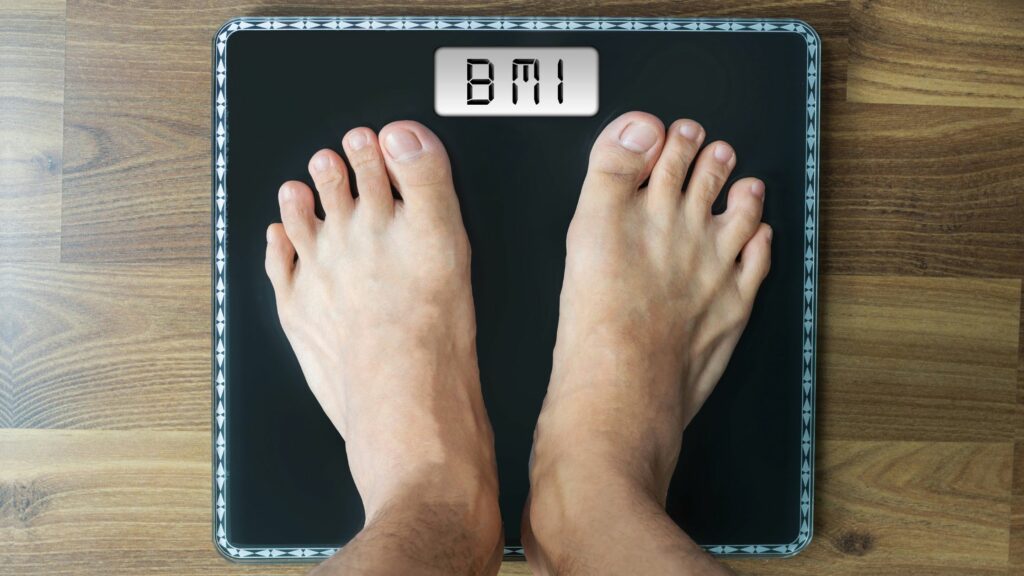Body mass index, or BMI, is a measure of body fat based on height and weight that applies to both adult men and women. BMI does not measure body fat directly, but it provides a reliable indicator of excess body fat. A high BMI can be an indicator of high body fatness. BMI can be used to screen for weight categories that may lead to health problems but it is not diagnostic of the amount of body fat. Use our BMI Calculator and find your BMI.
BMI was first introduced in the early 19th century by Belgian statistician Adolphe Quetelet. It was initially used to study obesity trends in adults. BMI has since been found to be a useful tool for predicting morbidity and mortality from various causes in different populations.
BMI is calculated by dividing a person’s weight in kilograms by their height in meters squared. The resulting number is then used to categorize people as underweight, normal, overweight, or obese. Underweight: BMI less than 18.5; Normal weight: BMI between 18.5-24.9; Overweight: BMI between 25-29.9; Obesity: BMI greater than 30
There are several limitations to using BMI as a measure of body fat. First, it does not directly measure body fat. Second, it does not account for differences in muscle mass or bone density. Third, it may overestimate body fat in people who are very muscular or who have a large frame size. Finally, it does not provide information on where the body fat is distributed which is important because abdominal fat is more strongly associated with some diseases than other types of fat.
Despite its limitations, BMI is still widely used because it is easy to calculate and predict health risks accurately enough for most purposes. It is also inexpensive to measure on a large scale.
What is Body Mass Index (BMI)?
Body Mass Index, or BMI, is a measure of body fatness based on height and weight. BMI does not directly measure body fat, but research has shown that it is a reliable indicator of body fatness for most people. BMI can be used to screen for overweight and obesity in adults.
How is BMI calculated?
To calculate BMI, divide your weight in pounds by your height in inches squared, then multiply by 703. For example, if you weigh 120 pounds and are 5 feet, 4 inches tall (64 inches), your BMI would be 20.8 kg/m2.
Limitations of BMI
BMI is not a perfect measure of body fatness, but it is the best measure we have available. One limitation of BMI is that it may overestimate body fatness in people who are muscle-bound, such as athletes. Another limitation is that it may underestimate body fatness in older adults and people with low levels of muscle mass.
What health risks are associated with high or low BMI?
People with a high BMI are at increased risk for many chronic diseases, including heart disease, stroke, diabetes, and some types of cancer. People with a low BMI are at increased risk for bone loss and other health problems.
How can I improve my BMI?

If you are overweight or obese, you can improve your BMI by losing weight. Even a small amount of weight loss can improve your health. If you are underweight, you can improve your BMI by gaining weight.
Are there any other measures of body fatness besides BMI?
There are other measures of body fatness, but they are usually more expensive and not as widely available as BMI. These include skinfold thickness measurements, bioelectrical impedance, dual-energy X-ray absorptiometry (DXA), and underwater weighing.
Where can I find more information about BMI?
For more information about BMI, visit the Centers for Disease Control and Prevention’s (CDC) website: www.cdc.gov/bmi/.
Facts about BMI
- Body Mass Index (BMI) is a number calculated from a person’s weight and height.
- BMI provides a reliable indicator of body fatness for most people.
- A high BMI can be an indicator of high body fatness.
- A low BMI can be an indicator of low body fatness.
- BMI does not measure body fat directly, but research has shown that BMI is closely related to direct measures of body fat, such as underwater weighing and dual-energy X-ray absorptiometry (DXA).
Final Words
The Body Mass Index (BMI) is a measure of body fat based on height and weight that applies to both adult men and women. BMI is used as a screening tool to identify possible weight problems in adults. However, BMI alone is not a diagnostic tool.
A health care provider should perform additional assessments in order to diagnose an individual with overweight or obesity. The BMI may also be used by researchers to study trends in the population and to track the prevalence of overweight and obesity.
BMI is a popular method of measuring someone’s body fat. However, many people think it is inaccurate and does not take into account muscle mass or bone density.
BMI FAQ
What is a good BMI for my age?
A good BMI for your age typically falls between 18.5 and 24.9. This range is considered a healthy weight for most people of your age and height. Maintaining a healthy weight is important for overall health and can help reduce your risk for various diseases and conditions, such as heart disease, stroke, type 2 diabetes, and certain types of cancer. If you are currently outside of this range, talk to your doctor about ways to safely reach a healthier weight.
What is a BMI calculator?
A BMI Calculator is a tool that helps you calculate your Body Mass Index. This index is a measure of body fat based on height and weight. It is used to determine whether someone is underweight, overweight, or obese. To use the calculator, you will need to know your height and weight. You can then input these numbers into the BMI formula, which is BMI = kg/m2.
What is the perfect BMI for a woman?

The perfect BMI for a woman falls between 18.5 and 24.9, according to medical experts. This range is based on the fact that women of this BMI are generally within a healthy weight range and are less likely to experience health problems related to being overweight or obese. Additionally, women of this BMI tend to have higher levels of energy and feel more comfortable in their own skin than those who fall outside of this range.
What is a good weight for a 65 year old woman?
The research indicates that for a 65-year-old woman, anything above 145 pounds is considered overweight. Obesity is defined as being 30 or more pounds over ideal body weight. For a woman of this age group, the ideal weight would be around 115 pounds.
Anything above 174 pounds would be considered obese. The percentages provided in the research are based on the Body Mass Index (BMI). The BMI is calculated by taking your weight in kilograms and dividing it by your height in meters squared.
What weight range should I be for my height?
There are a lot of different ways to answer this question, and ultimately it depends on what you are looking for. For instance, if you are trying to figure out what weight range is considered healthy for your height, you can consult a variety of resources that provide information on average or ideal body weights.
However, keep in mind that these ranges are generalities and may not be appropriate for everyone. If you are specifically interested in what weight range is considered attractive, that is often based on cultural norms and can vary considerably. So, while there are some general guidelines that you can use to help you determine an appropriate weight range for your height, it is important to remember that there is no one right answer.
What is a good BMI for a 68 year old woman?
According to doctors, it is ideal for most adults to keep their BMI between 18 and 24.9. However, research shows that older adults who are underweight experience more health issues and shorter life expectancy. Therefore, it is better for older adults to have a BMI between 25 and 27.
What is a normal BMI?
Body mass index, or BMI, is a measure of body fat based on height and weight that applies to both adult men and women. Below are the BMI ranges and associated categories. BMI below 18.5 – you’re in the underweight range. BMI between 18.5 and 24.9 – you’re in the healthy weight range. BMI between 25 and 29.9 – you’re in the overweight range. BMI between 30 and 39.9 – you’re in the obese range.
What does my BMI mean?
Body Mass Index, or BMI, is a mathematical calculation based on an individual’s weight and height. BMI is generally used as an assessment of whether someone is carrying too much body fat, although it isn’t a direct measurement of body fatness. A high BMI can indicate that a person has too much body fat, but there are exceptions. For example, athletes or people with very muscular builds may have a high BMI without having excessive amounts of body fat. However, for most people, a high BMI is a good indicator of high body fatness.
What is correct weight and height for age?
The ideal weight and height for a person of any age is dependent on many factors, including gender, bone structure, muscle-fat ratio, and genetics. However, there are some general trends that can be used to give an idea of what is considered a healthy weight and height for someone of a certain age.
In terms of height, it is generally accepted that people grow the most during their teenage years, with girls typically reaching their full adult height by around 16 years old and boys by around 18 years old. After this point, most people will only experience very small changes in height.
In terms of weight, Americans tend to gain weight throughout their 20s, 30s, and 40s, before leveling off or even losing a few pounds in their 50s and beyond. When it comes to calculating a healthy body mass index (BMI), there is no one-size-fits-all answer, as different people have different body types. However, a BMI of 19-24 is generally considered normal weight, while a BMI of 25-29 is considered overweight.
What does each BMI number mean?
The body mass index (BMI) is a measure that uses your height and weight to work out if your weight is healthy. The BMI calculation divides an adult’s weight in kilograms by their height in metres squared. A BMI of 25.0 or more is overweight, while the healthy range is 18.5 to 24.9. A BMI of 30.0 or more is obese. For most adults, an ideal BMI is in the 18.5-24.9 range. If your BMI is between 25 and 29.9, you are considered overweight and if it reaches 30, you are considered obese.
What is the BMI of a normal healthy person?

The body mass index (BMI) is a measure of body fat based on height and weight that applies to both adult men and women. A person with a BMI of 18.5 to 24.9 is considered to be in the normal or healthy range. For most people, BMI provides a good estimate of body fat. However, BMI does have some limitations. For example, it may not accurately reflect body fat in athletes or older adults who have lost muscle mass. In addition, BMI does not take into account differences in body fat distribution.
Some people, such as those with a pear-shaped body type, may have a high BMI but relatively little body fat. Conversely, others, such as those with an apple-shaped body type, may have a normal BMI despite having too much body fat. Despite these limitations, BMI is still a useful tool for assessing health risk.
How do I calculate my BMI in pounds?
There are a few steps in calculating one’s BMI in pounds. First, you need to know your weight in pounds and your height in inches. You can use a standard scale to weigh yourself and a tape measure to measure your height. Once you have these numbers, you can plug them into the following formula: weight (lb) / [height (in)]2 x 703. This will give you your BMI in pounds.
BMI is calculated by dividing weight in pounds (lb) by height in inches (in) squared and multiplying by a conversion factor of 703. The resulting number is then interpreted to see if someone is underweight, normal weight, overweight, or obese. A BMI under 18.5 means someone is considered underweight, while a BMI of 25 or above means someone is considered overweight.
What weight should I be based on age?
There are a few things to consider when thinking about what weight is appropriate for you based on your age. The first is to look at percentile ranges for weights of people your age. This can give you a general idea of whether you are underweight, average, or overweight for your age group. However, it is important to remember that everyone is different and so these ranges should only be used as a guide. Another thing to consider is whether you are growing at a normal rate for your age.
If you are not gaining or losing weight at a rate that is considered healthy for your age group, this could be a cause for concern. If you are unsure whether your weight gain or loss is within the healthy range, speak to your doctor.
In addition to Growth charts and percentiles, there are BMI calculations which are also used to determine if someone is at a healthy weight. To calculate your BMI, you need to know your height and weight. Once you have this information, you can use a BMI calculator to find out your score. A BMI score of 18.5-24.9 is considered healthy, while anything below or above this range is considered unhealthy.
It is important to keep in mind that these BMI calculations may not be accurate for everyone, especially those who are very muscular or have a lot of body fat. In general, though, BMIs can be a helpful way to get an idea of whether someone is at a healthy weight for their height.
If you are concerned about your weight, the best thing to do is talk to your doctor. They will be able to help you figure out if you are at a healthy weight and offer advice on how to reach or maintain a healthy weight if necessary.
What is a healthy BMI for women?
A healthy body mass index (BMI) for women is generally considered to be between 18.5 and 24.9. This range is based on a variety of factors, including height, weight, age, and overall health.
BMI is just one tool that can be used to assess whether someone is at a healthy weight, and it should be considered alongside other measures, such as waist circumference and body fat percentage. While there is no single definition of what constitutes a “healthy” BMI, the World Health Organization (WHO) recommends that adults aim to maintain a BMI of 18.5-24.9.
What is the average BMI for a man?
In the United States, the average adult man has a BMI of 26.6, while the average adult woman has a BMI of 26.5. BMI is a measure of body fat based on height and weight. It is used to estimate whether someone is underweight, overweight, or obese. A BMI of 25-29.9 is considered overweight, and a BMI of 30+ is considered obese.
How can I calculate my BMI?
Body Mass Index (BMI) is a simple calculation using a person’s height and weight. The formula for BMI is kg/m2, where kg is a person’s weight in kilograms and m2 is their height in meters squared. A BMI of 25.0 or more indicates that a person is overweight, while the healthy range is 18.5 to 24.9. BMI applies to most adults 18-65 years old.






